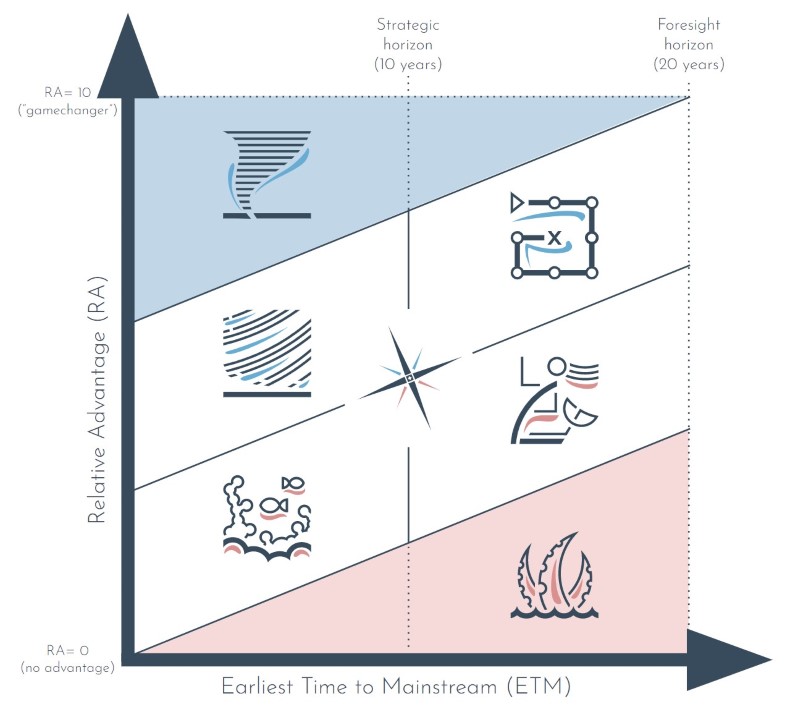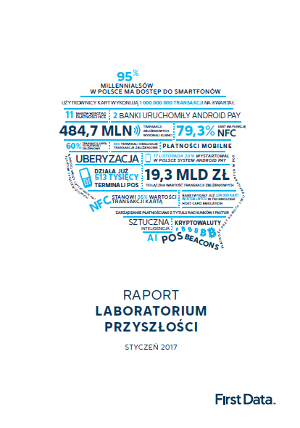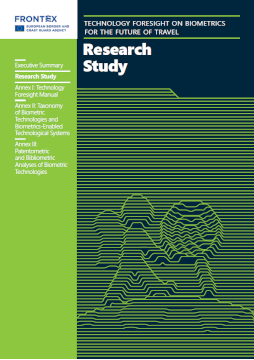
4CF Matrix
4CF Matrix is a simple tool developed for the purpose of identification, verification and systematisation of potential solutions developed in the process of strategic planning and strategic analyses. Each technology solution is evaluated according to two criteria:

Relative Advantage
(RA): the degree of improvement that the proposed solutions might bring to the realisation of a particular need. This is contrasted with today’s most popular solutions as well as with hypothetical future ones. The relative advantage is typically evaluated on a scale of 0-10, where 0 means lack of improvement in the realisation of a need, while 10 means major improvement – a “gamechanger”. The relative advantage evaluation should not take into consideration the time needed for implementation or barriers to entry. Both of these are included in the next criterion.

ETM
(Earliest Time to Mainstream): the minimal amount of time needed for the popularisation of a solution. This criterion takes into consideration aspects such as delays caused by technological, financial, social, or legal barriers. The moment of popularisation is defined as the time when a solution is available (in terms of distribution, but also e.g. financially) to the majority of the target group. It should be noted that the key factor is availability rather than the actual use of a solution; mass adoption is dependent on a number of other factors. ETM is typically estimated in years, with an upper limit determined in advance, usually on a scale of 0-20, where 0 means that the solution is already available on the market, while 20 means that 20 years or more are needed for it to become available.
A matrix structured with regard to the above criteria shows areas of importance for strategic planning: from an area of solutions which show little promise with regard to relative advantage but which could be implemented quickly, to very distant fields which contain groundbreaking solutions for a given market. Ignoring solutions that have been evaluated as highly advantageous and which are “just around the corner” can potentially be dangerous, as can investing in low-benefit solutions.
Areas on a 4CF Matrix have been named to help with the interpretation of results. Obviously, due to the character of the assessments, these areas can be considered as a guideline for interpreting the results rather than treated with mathematical precision. Placing solutions within the matrix in accordance with values resulting from the evaluation is a valuable starting point for further discussion as to their placement relative to other analysed solutions.


Rose of Winds – solutions close to the centre of the Matrix. In the case of solutions that – as a result of the evaluation – have ended up close to the centre of the matrix, caution is advised, as their location may be the result of the experts’ indecisiveness: when in doubt they tend to choose values close to the centre of the scale. This does not mean that no solutions actually belong in this area, but one must be certain what lies at the root of their evaluation. The Rose of Winds has another role as well: its tilt serves to illustrate the fact that a solution of a given level of relative advantage and with a short ETM may be more valuable than a solution with exactly the same level of relative advantage and longer ETM due to the dynamic nature of the market (as a reminder: relative advantage is assessed independently of ETM). Generally, as time goes on, market players introduce more and more sophisticated solutions, so that the level of advantage that is attractive nowadays may be of little value in a few years. This is reflected in all of the areas of the matrix, which are tilted just as the Rose of the Winds.

Tornadoes
Solutions with a combination of particularly high relative advantage and short ETM taking into account the outstanding benefits. These types of solutions have the highest disruptive influence on the analysed market.

Squalls
Solutions with a short ETM and a high relative advantage. These are solutions that may dramatically change the way a need is met in a short period of time, thus giving the one who implements it a huge advantage, and placing him way ahead of competition.

Pirate Treasure
Solutions with a long ETM but a high relative advantage. Solutions from this area require a bold decision: going for them means setting off on a long journey with no guarantee of success. The reward for those who succeed, however, is often worth the risk. It is worth pointing out that it might be equally risky to ignore hidden treasures and seek safer solutions.

Coral Reefs
Solutions with a short ETM, but also a low relative advantage. Choosing a solution placed within this area is risky, as it may entail the loss of an opportunity for developing a long-term strategic advantage in the name of short-term benefits. Exploring for reefs is therefore a poor choice in the long run, but if the concepts in this area do not have high entry barriers, they may be worth going slightly “off course”. This should, however, be a conscious choice, and the decision to invest time and resources in a solution from this area requires great caution, so as not to lose sight of the search for more future-oriented solutions.

Sirens
Solutions with a long ETM and comparatively low relative advantage. Following a siren’s voice may be dangerous, since solutions from this area involve the substantial risk of investing time and resources into a solution which might not prove successful and consequently the risk of losing strategic advantage by failing to take advantage of market opportunities.

Krakens
On the other end of the spectrum then the Tornadoes, Krakens are solutions with a combination of particularly low relative advantage and long ETM taking into account the modest benefits. These solutions are to be avoided, due to extremely high risk of spending resources on a short-sighted solution.
4CF Matrix was used in tens of implementations, ranging from high-technology, through defence, IT, retail to energy sector emerging solutions and technologies.
Examples of use
Stay updated! Subscribe to our newsletter:
By subscribing to our newsletter, you consent to the processing of the provided data. The data controller is 4CF Sp. z o.o., its registered office is located in Warsaw, 10/14 Trzech Krzyży Square, postal code: 00-499.
We process your data solely for the purpose of sending information about 4CF Sp. z o.o. and its activities via e-mail. Your data will be processed until your consent is revoked through a link that will be included in each newsletter. The withdrawal of consent shall not affect the lawfulness of processing based on consent before its withdrawal. Providing your data is voluntary, but necessary if you wish to receive information about 4CF Sp. z o.o. and its activities. We may transfer the data to our suppliers of services related to the processing of personal data, e.g. IT service providers. Such entities process data on the basis of a contract with our company and only in accordance with our instructions. You have the right to request access to your personal data, its rectification, deletion or limitation of processing, as well as the right to lodge a complaint with the supervisory authority. More information about your rights and about the processing of your personal data can be found in our privacy policy.



